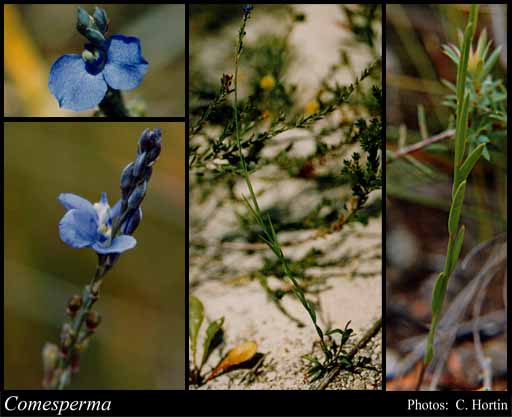- Reference
- Nov.Holl.Pl. p21, t. 159. (1806)
- Name Status
- Current

Scientific Description
Family Polygalaceae.
Habit and leaf form. Shrubs, or herbs, or lianas; deciduous (often), or evergreen; bearing essential oils, or without essential oils. Herbs perennial; plants with neither basal nor terminal concentrations of leaves. Self supporting, or climbing. Mesophytic, or xerophytic. Leaves alternate; spiral; ‘herbaceous’, or leathery; petiolate to sessile; non-sheathing; gland-dotted, or not gland-dotted; simple. Leaf blades entire; pinnately veined; cross-venulate. Leaves without stipules. Leaf blade margins entire. Leaves without a persistent basal meristem. Stem anatomy. Nodes unilacunar. Secondary thickening developing from a conventional cambial ring, or anomalous.
Reproductive type, pollination. Fertile flowers hermaphrodite. Unisexual flowers absent. Plants hermaphrodite. Floral nectaries present. Nectar secretion from receptacle. Entomophilous. Pollination mechanism conspicuously specialized, or unspecialized.
Inflorescence and flower features. Flowers aggregated in ‘inflorescences’, or solitary (sometimes); in racemes. The terminal inflorescence unit cymose. Inflorescences terminal, or axillary (occasionally). Flowers bracteate; bracteolate; small; very irregular; medianly zygomorphic. The floral asymmetry involving the perianth and involving the androecium. Flowers ‘pseudo-papilionaceous’; cyclic; pentacyclic. Free hypanthium absent. Hypogynous disk present; annular (around G). Perianth with distinct calyx and corolla; 8, or 10; 2 -whorled; isomerous, or anisomerous (usually). Calyx 5; 1 -whorled; more or less polysepalous; imbricate; unequal but not bilabiate (the outer three members usually smaller than the inner ones; inner members (wings) usually large); not persistent; with the median member posterior. Corolla 3, or 5 (the two lateral petals, when present, rudimentary and adnate to the staminal tube); 1 -whorled; gamopetalous (at the base); unequal but not bilabiate (zygomorphic, the median anterior member keel-like, with the hood enclosing the stamens and ovary; the 2 wing petals adnate towards the base to the keel); white, or cream, or yellow, or purple. Corolla members entire. Androecium (6–)8. Androecial members adnate (to the corolla); coherent; 1 - adelphous (the filaments united below into a split tube, this adnate to the upper petals); 1 -whorled. Androecium exclusively of fertile stamens. Stamens (6–)8. Anthers basifixed; dehiscing via short slits (slit falciform, appearing as an apical pore); unilocular; bisporangiate (by reduction). Gynoecium 2 carpelled. The pistil 2 celled. Gynoecium syncarpous; synstylovarious to eu-syncarpous; superior. Ovary plurilocular; 2 locular. Gynoecium median; stylate. Styles 1 (incurved, narrowly to broadly winged); forked; apical. Stigmas 1; 2 - lobed; dry type; non-papillate; Group II type. Placentation axile. Ovules 1 per locule; pendulous; epitropous; with ventral raphe; arillate, or non-arillate; anatropous, or hemianatropous.
Fruit and seed features. Fruit non-fleshy; dehiscent; a capsule. Capsules loculicidal. Seeds endospermic, or non-endospermic. Endosperm oily. Seeds non-arillate; conspicuously hairy, or not conspicuously hairy; with a tuft of hairs (often caducous). Cotyledons 2. Embryo straight.
Physiology, biochemistry. Aluminium accumulation not found.
Geography, cytology, number of species. Native of Australia. Not endemic to Australia. Australian states and territories: Western Australia, Northern Territory, and Queensland. Northern Botanical Province.